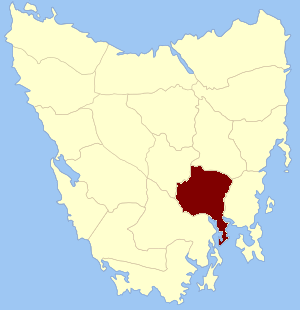Monmouth Land District facts for kids
Quick facts for kids MonmouthTasmania |
|||||||||||||||
|---|---|---|---|---|---|---|---|---|---|---|---|---|---|---|---|

Location in Tasmania
|
|||||||||||||||
| LGA(s) | City of Clarence | ||||||||||||||
|
|||||||||||||||

Monmouth Land District is a special area in Tasmania, Australia. It's one of the twenty "land districts" that help divide up the land for official records and maps. Think of it like a big, old-fashioned way of organizing land. It used to be called one of the 18 "counties" of Tasmania.
Monmouth Land District is bordered by the River Derwent to the south. The Clyde River forms its western border. A small part of the Jordan River is to its north.
This district includes parts of the larger Hobart area. These are the parts found on the east side of the Derwent River. Places like Rosny Park and Bridgewater are in Monmouth. It also includes towns further inland, such as Kempton and Hamilton.
History of Monmouth Land Divisions
Back in the early days of the colony, land needed to be organized. On January 15, 1836, George Arthur was the Lieutenant Governor of Van Diemen's Land (which is now Tasmania). He announced the very first counties and parishes that would be surveyed. This was published in a newspaper called The Hobart Town Courier.
Early Land Divisions: Counties and Parishes
The idea was to divide the land into large "counties" and smaller "parishes." These divisions helped the government keep track of land ownership. They also made it easier to manage the growing colony.
Monmouth was one of these original counties. Its borders were carefully described. It was next to Somersetshire to the north. The Derwent River formed part of its western and southern boundaries. It also included areas like Storm Bay and Frederick Henry Bay. Even small islands like Betsey Island and Iron Pot Island were part of Monmouth.
At that time, many "hundreds" and "parishes" were named within these counties. A "hundred" was a group of parishes. These smaller divisions helped to organize the land even more. They were important for surveying and setting up new settlements.

